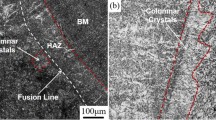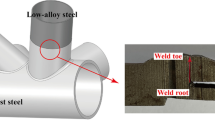Abstract
Weld residual stress affects joint performance in terms of the fatigue life and resistance to stress corrosion cracking. Thus far, the weld residual stress has been discussed mainly at the scale of the joint—the macroscopic scale. However, the weld residual stress can be inhomogeneous at the microscopic scale like a crystal grain; this aspect has not been discussed well. In this study, a numerical simulation model was developed to calculate the inhomogeneous distribution of the microscopic residual stress, based on the both-ends-fixed bar model. The bar was modeled by a polycrystalline aggregate, and the elastic and plastic anisotropy were defined for each grain. Thermal cycles with various peak temperatures were applied on the both-ends-fixed polycrystalline bar, and the evolution of the microscopic stress was simulated. The elastic and plastic anisotropy of the grains affected the inhomogeneity of the microscopic stress distribution. Elastic anisotropy caused inhomogeneity under elastic loading, whereas plastic anisotropy affected that under plastic loading. It was demonstrated that a microscopic stress higher than the applied macroscopic stress was generated when anisotropy was taken into consideration.












Similar content being viewed by others
References
Higuchi R, Mochizuki M, Toyoda M (2007) FEM-MD Combined method for investigation on effects of microscopic heterogeneity near weld zone on strength characteristics. Weld World 51:29–34. https://doi.org/10.1007/BF03266583
R. Hill (1948) A theory of the yielding and plastic flow of anisotropic metals, Proc Ryl Soc of London, 193:281–297.
Hure J, El Shawish S, Cizelj L, Tanguy B (2016) Intergranular stress distributions in polycrystalline aggregates of irradiated stainless steel. J Nucl Mater 476:231–242. https://doi.org/10.1016/j.jnucmat.2016.04.017
Kadkhodapour J, Schmauder S, Raabe D, Ziaei-Rad S, Weber U, Calcagnotto M (2011) Experimental and numerical study on geometrically necessary dislocations and non-homogeneous mechanical properties of the ferrite phase in dual phase steels. Acta Mater 59:4387–4394. https://doi.org/10.1016/j.actamat.2011.03.062
Mikami Y, Oda K, Mochizuki M (2013) Effect of crystal plasticity parameters on microscopic stress distribution in polycrystalline aggregate model. Journal of Multiscale Modelling 05:01. https://doi.org/10.1142/S1756973713500030
Okamoto K, Kaneda J, Yoshinari A, Aono Y, Iwata Y (2000) Influence of alloy elements on physical and mechanical properties of single crystalline austenite stainless steels. J Soc Mat Sci Japan 49:638–644. https://doi.org/10.2472/jsms.49.638
Satoh K, Ohnishi T (1969) Transient thermal stresses of weld heat-affected zone by both-ends-fixed bar analogy. J Japan Welding Soc 38:359–371. https://doi.org/10.2207/qjjws1943.38.359
Simonovski I, Cizelj L (2011) Automatic parallel generation of finite element meshes for complex spatial structures. Comput Mater Sci 50:1606–1618. https://doi.org/10.1016/j.commatsci.2010.12.014
Tanaka K, Suzuki K, Akiniwa Y (2006) Evaluation of residual stresses by x-ray diffraction—fundamentals and applications—. Yokendo Ltd., Tokyo
Weyer S, Frohlich A (2002) Automatic finite element meshing of planer Voronoi tessellations. Eng Fract Mech 69:945–958. https://doi.org/10.1016/S0013-7944(01)00124-2
Author information
Authors and Affiliations
Corresponding author
Additional information
Publisher’s note
Springer Nature remains neutral with regard to jurisdictional claims in published maps and institutional affiliations.
Recommended for publication by Commission X - Structural Performances of Welded Joints - Fracture Avoidance
Rights and permissions
About this article
Cite this article
Mikami, Y., Sadakane, W. & Mochizuki, M. Numerical simulation of microscopic residual stress evolution in polycrystalline aggregate subjected to weld thermal cycle. Weld World 64, 105–114 (2020). https://doi.org/10.1007/s40194-019-00811-3
Received:
Accepted:
Published:
Issue Date:
DOI: https://doi.org/10.1007/s40194-019-00811-3




